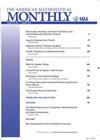Ten Points on a Cubic
IF 0.4
4区 数学
Q4 MATHEMATICS
引用次数: 0
Abstract
AbstractThe 16-year old Blaise Pascal found an incidence relation that holds when six points lie on a conic. A century later, Braikenridge and Maclaurin extended Pascal’s result to a straightedge construction that characterizes when six points lie on a conic. Nearly 400 years later, we develop a straightedge construction to check whether ten points lie on a cubic curve.MSC: 14H5051A20 AcknowledgmentWe thank Bernd Sturmfels for suggesting the problem to us and Mike Roth for helpful discussions. We are grateful to J. Chris Fisher for suggesting an alternate approach to Construction 2 and for encouraging feedback. The computer algebra system MAGMA [Citation4] was extremely helpful and all figures in the paper were produced using GeoGebra [Citation16], which is a great resource for developing geometric intuition. We thank the members of the Editorial Board of the MONTHLY for their suggestions and advice. We also thank the anonymous referees for carefully reading the manuscript and providing many helpful suggestions.Notes1 Apparently, Hadamard was paraphrasing Paul Painlevé [Citation19], the French mathematician and statesman who served twice as Minister of War and twice as Prime Minister of France.2 There seems to be some controversy about the spelling of Steiner’s first name. The authoritative version of his collected works [Citation23] gives the author’s name spelled with a k and the subject’s name spelled with a c. Perhaps this confusion is common among people whose work is important enough to be translated into many languages.3 https://www.cut-the-knot.org/pythagoras/PPower.shtmlAdditional informationNotes on contributorsWill TravesWILL TRAVES(https://orcid.org/0000-0002-8115-1243) nearly failed freshman physics at Queen’s University but went on to become a professor and past chair of the Naval Academy mathematics department. His research interests include geometry, data science, and operations research.United States Naval Academy, Mail Stop 9E, Annapolis, MD 21402, USAtraves@usna.eduDavid WehlauDavid Wehlau(https://orcid.org/0000-0002-0272-8404) received his Ph.D. from Brandeis University and is a professor and past head of the Department of Mathematics and Computer Science at the Royal Military College of Canada. He is also a professor at Queen’s University and enjoys being able to work with mathematics students at both institutions.Royal Military College of Canada, PO Box 17000 Stn Forces, Kingston, ON, K7K 7B4, Canadawehlau@rmc.ca一个立方体上有十个点
16岁的布莱兹·帕斯卡发现,当6个点位于一条圆锥曲线上时,存在一种关联关系。一个世纪后,Braikenridge和Maclaurin将Pascal的结果扩展到一个直线结构,该结构的特征是当六个点位于圆锥上时。近400年后,我们发明了一种直尺结构来检查是否有十个点位于一条三次曲线上。感谢Bernd Sturmfels向我们提出这个问题,并感谢Mike Roth进行了有益的讨论。我们非常感谢J. Chris Fisher提出了构建2的替代方法并鼓励反馈。计算机代数系统MAGMA [Citation4]非常有帮助,论文中的所有图形都是使用GeoGebra [Citation16]生成的,这是一个培养几何直觉的伟大资源。我们感谢《月报》编委会成员的建议和意见。我们也感谢匿名审稿人仔细阅读稿件并提供了许多有益的建议。注1很明显,阿达玛尔是在转述保罗·潘列维尔的话。潘列维尔是法国数学家和政治家,曾两次担任法国战争部长和总理。2关于施泰纳名字的拼写似乎有些争议。在他的文集[引文23]的权威版本中,作者的名字用k拼写,而主题的名字用c拼写。也许这种混淆在那些作品重要到足以被翻译成多种语言的人中间很常见。3 https://www.cut-the-knot.org/pythagoras/PPower.shtmlAdditional信息投稿人备注will TRAVES will TRAVES(https://orcid.org/0000-0002-8115-1243)在女王大学的大一物理专业差点不及格,但后来成为了一名教授,并担任过海军学院数学系的系主任。他的研究兴趣包括几何、数据科学和运筹学。美国海军学院,Mail Stop 9E, Annapolis, MD 21402, USAtraves@usna.eduDavid WehlauDavid Wehlau(https://orcid.org/0000-0002-0272-8404)获得布兰代斯大学博士学位,现为加拿大皇家军事学院数学与计算机科学系教授和前任系主任。他也是女王大学的教授,很高兴能够与这两所大学的数学学生一起工作。加拿大皇家军事学院,邮政信箱17000 Stn部队,金斯敦,ON, K7K 7B4, Canadawehlau@rmc.ca
本文章由计算机程序翻译,如有差异,请以英文原文为准。
求助全文
约1分钟内获得全文
求助全文
来源期刊

American Mathematical Monthly
Mathematics-General Mathematics
CiteScore
0.80
自引率
20.00%
发文量
127
审稿时长
6-12 weeks
期刊介绍:
The Monthly''s readers expect a high standard of exposition; they look for articles that inform, stimulate, challenge, enlighten, and even entertain. Monthly articles are meant to be read, enjoyed, and discussed, rather than just archived. Articles may be expositions of old or new results, historical or biographical essays, speculations or definitive treatments, broad developments, or explorations of a single application. Novelty and generality are far less important than clarity of exposition and broad appeal. Appropriate figures, diagrams, and photographs are encouraged.
Notes are short, sharply focused, and possibly informal. They are often gems that provide a new proof of an old theorem, a novel presentation of a familiar theme, or a lively discussion of a single issue.
Abstracts for articles or notes should entice the prospective reader into exploring the subject of the paper and should make it clear to the reader why this paper is interesting and important. The abstract should highlight the concepts of the paper rather than summarize the mechanics. The abstract is the first impression of the paper, not a technical summary of the paper. Excessive use of notation is discouraged as it can limit the interest of the broad readership of the MAA, and can limit search-ability of the article.
 求助内容:
求助内容: 应助结果提醒方式:
应助结果提醒方式:


